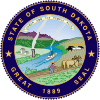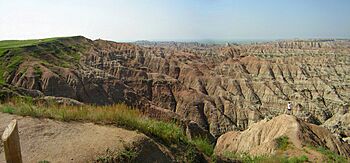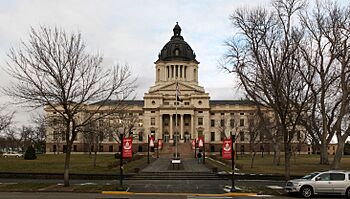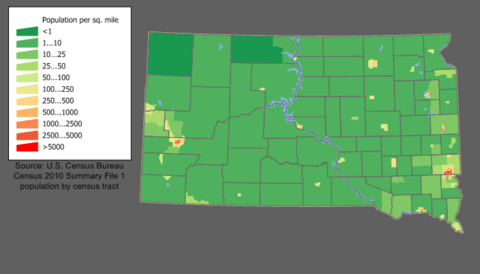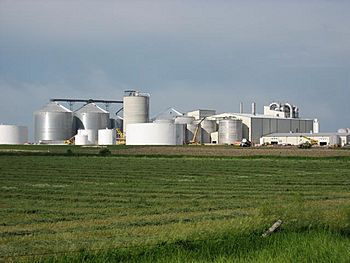South Dakota facts for kids
Quick facts for kids
South Dakota
Dakȟóta itókaga (Lakota)
|
|||
|---|---|---|---|
|
|||
| Nickname(s):
The Mount Rushmore State (official)
|
|||
| Motto(s):
Under God, the People Rule
|
|||
| Anthem: "Hail, South Dakota!" | |||

Location of South Dakota within the United States
|
|||
| Country | United States | ||
| Before statehood | Dakota Territory | ||
| Admitted to the Union | November 2, 1889 (40th) | ||
| Capital | Pierre | ||
| Largest city | Sioux Falls | ||
| Largest county or equivalent | Minnehaha County | ||
| Largest metro and urban areas | Sioux Falls | ||
| Legislature | South Dakota Legislature | ||
| • Upper house | Senate | ||
| • Lower house | House of Representatives | ||
| Judiciary | South Dakota Supreme Court | ||
| U.S. senators | John Thune (R) Mike Rounds (R) |
||
| U.S. House delegation | Dusty Johnson (R) (list) | ||
| Area | |||
| • Total | 77,116 sq mi (199,729 km2) | ||
| • Land | 75,811 sq mi (196,350 km2) | ||
| • Water | 1,305 sq mi (3,379 km2) 1.7% | ||
| Area rank | 17th | ||
| Dimensions | |||
| • Length | 380 mi (610 km) | ||
| • Width | 210 mi (340 km) | ||
| Highest elevation | 7,244 ft (2,208 m) | ||
| Lowest elevation
(Big Stone Lake on Minnesota border)
|
968 ft (295 m) | ||
| Population
(2024)
|
|||
| • Total | |||
| • Rank | 46th | ||
| • Density | 11.50/sq mi (4.44/km2) | ||
| • Density rank | 46th | ||
| • Median household income | $71,800 (2023) | ||
| • Income rank | 33rd | ||
| Demonym(s) | South Dakotan | ||
| Language | |||
| • Official language | English, Sioux (official indigenous language) | ||
| • Spoken language | English, Spanish (2.06%), Dakota (1.39%), German (1.37%) | ||
| Time zones | |||
| eastern half | UTC−06:00 (Central) | ||
| • Summer (DST) | UTC−05:00 (CDT) | ||
| western half | UTC−07:00 (Mountain) | ||
| • Summer (DST) | UTC−06:00 (MDT) | ||
| USPS abbreviation |
SD
|
||
| ISO 3166 code | US-SD | ||
| Traditional abbreviation | S.D., S.Dak. | ||
| Latitude | 42°29′ N to 45°56′ N | ||
| Longitude | 96°26′ W to 104°03′ W | ||
South Dakota (in Sioux: Dakȟóta itókaga) is a state in the United States. It is located in the middle of the country, far from any ocean. South Dakota is part of the Great Plains region. The state gets its name from the Dakota Sioux tribe. Many Sioux people still live here, and there are nine reservations in the state.
South Dakota is the 17th largest state by land area. However, it is the fifth least populated state. This means there are not many people living in a large area. Pierre is the state capital. Sioux Falls is the biggest city, with about 213,900 people.
The Missouri River cuts South Dakota in half. This creates two different areas: "East River" and "West River". South Dakota shares borders with North Dakota to the north, Minnesota to the east, Iowa to the southeast, Nebraska to the south, Wyoming to the west, and Montana to the northwest.
People have lived in this area for thousands of years. The Sioux became the main group by the early 1800s. In the late 1800s, more European-Americans moved in. This happened after gold was found in the Black Hills. Railroads were also built from the east. New miners and settlers led to several wars with Native Americans. These wars ended with the Wounded Knee Massacre in 1890.
South Dakota became a state on November 2, 1889. It was the southern part of the old Dakota Territory. It joined the U.S. at the same time as North Dakota. President Benjamin Harrison signed the papers for both states. He mixed them up so no one would know which one became a state first.
Important events in the 1900s included the Dust Bowl and Great Depression. The government spent more money on farming and defense in the 1940s and 1950s. Farming also became more industrial, meaning fewer family farms. Most people live in eastern South Dakota. The rich soil there is used to grow many crops. West of the Missouri River, ranching is more common. The economy there also relies on tourism and defense.
Most Native American reservations are in West River. The Black Hills are a group of mountains covered in pine trees. They are sacred to the Sioux people. Mount Rushmore, a famous tourist spot, is in the Black Hills. South Dakota has a continental climate. This means it has four clear seasons. It gets moderate rain in the east and less rain in the west. The state's nature includes plants and animals typical of a North American grassland.
South Dakota's government is mostly run by the Republican Party. This state has voted for Republican presidents for many years. South Dakota has always been known for its farms and rural life. But recently, it has tried to grow other types of businesses. This helps attract and keep people living there. The state's history and rural character still shape its culture.
Contents
- History of South Dakota
- Geography of South Dakota
- South Dakota's Government
- People of South Dakota
- South Dakota's Economy
- Getting Around South Dakota
- South Dakota's Culture
- Cities and Towns in South Dakota
- Media in South Dakota
- Education in South Dakota
- Sports and Fun in South Dakota
- State Symbols
- See also
History of South Dakota
Early Times in South Dakota
People have lived in the area now called South Dakota for thousands of years. The first people were hunters and gatherers. They disappeared around 5000 BC. Between 500 AD and 800 AD, a group called the Mound Builders lived in central and eastern South Dakota. In the 1300s, the Crow Creek Massacre happened. Hundreds of people were killed near the Missouri River.
By 1500, the Arikara people lived in the Missouri River valley. Europeans first arrived in 1743. The LaVérendrye brothers explored the region. They claimed the land for France. This area was part of a larger French territory called Louisiana. In 1762, it became part of Spanish Louisiana. By the early 1800s, the Sioux people became the main group in the area.
Becoming Part of the United States
In 1803, the United States bought the Louisiana Territory from France. This huge area included most of South Dakota. President Thomas Jefferson sent the Lewis and Clark Expedition to explore it. In 1817, an American fur trading post was built at what is now Fort Pierre. This was the start of continuous American settlement.
In 1858, the Yankton Sioux signed a treaty. They gave up most of eastern South Dakota to the United States. New towns like Sioux Falls (1856) and Yankton (1859) were started. In 1861, the Dakota Territory was created. It included North and South Dakota, and parts of Montana and Wyoming. More people moved to the area. This increased even more after a railroad link was built in 1873.
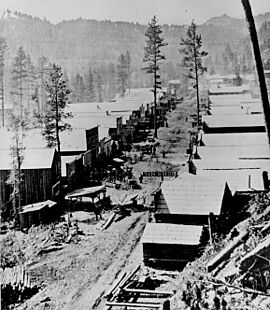
In 1874, gold was found in the Black Hills. This happened during a military trip led by George A. Custer. Miners began to enter the land illegally. This land was promised to the Lakota Sioux in 1868. The Sioux did not want to give up their land. This led to war. The U.S. won and divided the Great Sioux Reservation. The Lakota were settled on smaller reservations. In 1980, the Supreme Court ordered payment to the Lakota. But the Lakota still want their land back.
The Dakota Territory grew quickly. People in the southern part wanted to separate from the northern part. In 1887, people voted to divide the territory. On November 2, 1889, President Benjamin Harrison made South Dakota and North Dakota states. He mixed up the papers so no one would know which was first.
On December 29, 1890, the Wounded Knee Massacre happened. This was on the Pine Ridge Indian Reservation. It was one of the last big fights between the U.S. and the Lakota Sioux Nation. At least 146 Sioux people were killed, including women and children. 31 U.S. soldiers also died.
South Dakota in the 1900s and Today

The 1930s were very hard for South Dakota. There was little rain and very hot weather. Farming methods also caused problems. This led to the Dust Bowl. Huge dust storms blew away fertile soil. Many crops were ruined. Many people left South Dakota because of the Dust Bowl and the Great Depression. The state's population dropped by over 7% between 1930 and 1940.
Things got better when the U.S. entered World War II in 1941. Demand for farm products and factory goods grew. In 1944, the Pick–Sloan Plan led to building six large dams on the Missouri River. Four of these dams are partly in South Dakota. These dams help control floods, make electricity, and create places for boating and fishing.
In recent years, South Dakota's economy has changed. It is no longer just about farming. Tourism has grown a lot since the mid-1900s. The Black Hills became a very popular place to visit. The financial industry also grew. Citibank moved its credit card business to Sioux Falls in 1981. Other financial companies followed. South Dakota was the first state to remove limits on interest rates.
In 2007, the old Homestake gold mine became a new science lab. It is called the Deep Underground Science and Engineering Laboratory. Even with growth, many rural areas have lost people. Young, educated adults often move to bigger cities like Rapid City or Sioux Falls. Modern farming means fewer small family farms. This has caused challenges for small towns. However, South Dakota is often ranked as a great place to live. In 2018, it was named the happiest and healthiest state.
Geography of South Dakota
South Dakota is in the north-central United States. It is part of the Midwest region. It is also part of the Great Plains. The western part of South Dakota feels more like the West. South Dakota covers about 77,116 square miles (199,729 km2). This makes it the 17th largest state.
Black Elk Peak is the highest point in the state. It is 7,242 feet (2,208 m) high. The lowest point is the shore of Big Stone Lake. It is 966 feet (295 m) high. South Dakota borders North Dakota to the north, Nebraska to the south, Iowa and Minnesota to the east, and Wyoming and Montana to the west. The exact center of the U.S. is west of Castle Rock.
The Missouri River is the biggest river in South Dakota. Other important rivers include the Cheyenne, James, Big Sioux, and White Rivers. Eastern South Dakota has many natural lakes. These were mostly formed by glaciers. Dams on the Missouri River also created four large lakes. These are Lake Oahe, Lake Sharpe, Lake Francis Case, and Lewis and Clark Lake.
Regions and Landforms
South Dakota has three main regions. These are eastern South Dakota, western South Dakota, and the Black Hills. The Missouri River divides the state. It marks differences in land, people, and politics. The Black Hills are mountains that are very different from the land around them. Sometimes, the Black Hills are grouped with western South Dakota. Then people talk about "West River" and "East River".
Eastern South Dakota usually gets more rain. It also has flatter land. This area includes the Coteau des Prairies, the Dissected Till Plains, and the James River Valley. The Coteau des Prairies is a high flat area. The James River Basin is mostly low, flat land. The Dissected Till Plains have rolling hills and rich soil. Most of eastern South Dakota is covered by layers of rock and soil. These were left by glaciers about two million years ago.
The Great Plains cover most of western South Dakota. West of the Missouri River, the land is drier and rougher. It has rolling hills, plains, and steep, flat-topped hills called buttes. South of the Black Hills are the South Dakota Badlands. The unique geology here comes from erosion, ancient sea life, and volcanic material.
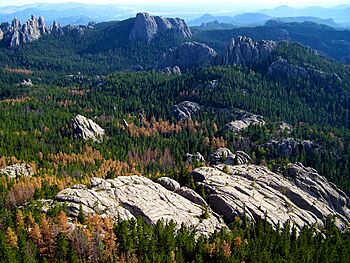
The Black Hills are in the southwest part of South Dakota. They also go into Wyoming. These low mountains cover about 6,000 square miles (15,500 km2). Their peaks rise 2,000 to 4,000 feet (600 to 1,200 m) above the surrounding land. Black Elk Peak is the highest point in the Black Hills. It is also the highest point in the U.S. east of the Rocky Mountains. The oldest rocks in the state are in the Black Hills. They are two billion years old.
Plants and Animals
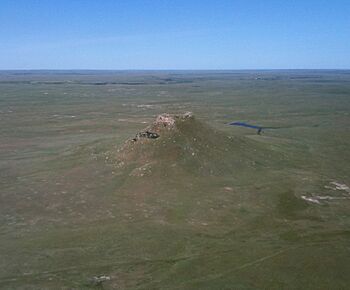
Most of South Dakota is a temperate grassland. This means it has a lot of grass. Trees like cottonwoods, elms, and willows grow near rivers. They also grow in rows of trees planted for protection.
Animals in this area include bison, deer, pronghorn, coyotes, and prairie dogs. The state bird is the ring-necked pheasant. It was brought from China and lives well here. Many bald eagles live throughout the state, especially near the Missouri River. Rivers and lakes have fish like walleye, carp, pike, and bass. The Missouri River also has the ancient paddlefish.
The Black Hills are higher and get more rain. So, their plants and animals are different. The mountains are covered with different kinds of pine trees. These include ponderosa and lodgepole pines, and spruces. Animals in the Black Hills include deer, elk, bighorn sheep, mountain goats, and mountain lions. Streams and lakes have several types of trout.
South Dakota's Climate
South Dakota has a continental climate. This means it has four distinct seasons. Winters are cold and dry. Summers are warm and somewhat humid. In summer, the average high temperature is often near 90°F (32°C). It cools to about 60°F (16°C) at night. Temperatures can go above 100°F (38°C) several times a year. Winters are cold. January high temperatures are usually below freezing. Low temperatures are often below 10°F (-12°C). The hottest temperature ever recorded was 120°F (49°C) in Usta. The coldest was -58°F (-50°C) in McIntosh.
The amount of rain South Dakota gets each year varies. The northwest is semi-arid, getting about 15 inches (38 cm) of rain. The southeast is semi-humid, getting about 25 inches (64 cm). A small area in the Black Hills gets the most rain, almost 30 inches (76 cm) per year.
Summers in South Dakota often have strong thunderstorms. These can bring high winds, thunder, and hail. The eastern part of the state is in Tornado Alley. South Dakota has about 30 tornadoes each year. Severe blizzards and ice storms are common in winter.
| Place | Jan | Feb | Mar | Apr | May | Jun | Jul | Aug | Sep | Oct | Nov | Dec |
|---|---|---|---|---|---|---|---|---|---|---|---|---|
| Aberdeen | 24 / 6 (−4 / −14) |
29 / 11 (−2 / −12) |
42 / 23 (6 / −5) |
59 / 35 (15 / 2) |
70 / 47 (21 / 8) |
79 / 57 (26 / 14) |
84 / 61 (29 / 16) |
82 / 58 (28 / 14) |
73 / 49 (23 / 9) |
58 / 36 (14 / 2) |
41 / 22 (5 / −6) |
27 / 10 (−3 / −12) |
| Huron | 27 / 9 (−3 / −13) |
32 / 14 (0 / −10) |
45 / 25 (7 / −4) |
60 / 37 (16 / 3) |
71 / 48 (22 / 9) |
80 / 58 (27 / 14) |
86 / 63 (30 / 17) |
83 / 61 (28 / 16) |
75 / 51 (24 / 11) |
60 / 51 (16 / 11) |
43 / 25 (6 / −4) |
30 / 13 (−1 / −11) |
| Rapid City | 37 / 18 (3 / −8) |
40 / 20 (4 / −7) |
49 / 27 (9 / −3) |
59 / 36 (15 / 2) |
68 / 46 (20 / 8) |
78 / 55 (26 / 13) |
86 / 61 (30 / 16) |
85 / 60 (29 / 16) |
75 / 50 (24 / 10) |
61 / 39 (16 / 4) |
47 / 28 (8 / −2) |
37 / 19 (3 / −7) |
| Sioux Falls | 27 / 10 (−3 / −12) |
32 / 15 (0 / −9) |
45 / 26 (7 / −3) |
60 / 38 (16 / 3) |
71 / 49 (22 / 9) |
80 / 59 (27 / 15) |
84 / 64 (29 / 18) |
81 / 61 (27 / 16) |
74 / 52 (23 / 11) |
60 / 39 (16 / 4) |
43 / 26 (6 / −3) |
30 / 14 (−1 / −10) |
National Parks and Monuments
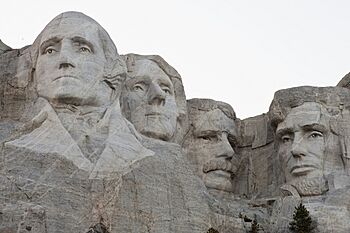
South Dakota has several places managed by the National Park Service. There are two national parks in the state's southwest. Wind Cave National Park was created in 1903. It has a large cave system and many bison. Badlands National Park was created in 1978. It features colorful, eroded landscapes and grasslands. Mount Rushmore National Memorial in the Black Hills was made in 1925. It has a sculpture of four U.S. Presidents carved into the mountain.
Other sites include Jewel Cave National Monument and the Lewis and Clark National Historic Trail. The Minuteman Missile National Historic Site shows a old nuclear missile silo. The Missouri National Recreational River is also managed by the National Park Service. The Crazy Horse Memorial is a huge mountain sculpture being built with private money. The Mammoth Site is a privately owned attraction. It is a real dig site with many mammoth remains.
South Dakota's Government
Like other U.S. states, South Dakota's government has three parts. These are the executive, legislative, and judicial branches. This is similar to the U.S. federal government. The rules for the state government are in the Constitution of South Dakota. This is the highest law in the state. The constitution can be changed by a vote of the legislature or by the people.
The Governor of South Dakota leads the executive branch. The governor can sign or reject bills passed by the legislature. They are also the commander of the South Dakota National Guard. The governor appoints a cabinet and can pardon people convicted of crimes. A governor serves for four years. They can serve no more than two terms in a row.
The state legislature has two parts. These are the Senate and the House of Representatives. The Senate has 35 members. The House has 70 members. South Dakota is divided into 35 districts. Voters choose two representatives and one senator from each district. The legislature meets every year starting in January. It can also meet if the governor calls a special session.
The judicial branch has several levels of courts. The state supreme court is the highest court. It has four justices and a chief justice. Below the supreme court are the circuit courts. There are 41 circuit judges in seven judicial areas. Below them are the magistrate courts. These courts handle smaller criminal and civil cases.
Federal Representation
South Dakota has three people representing it in the U.S. government. These are Senator John Thune, Senator Mike Rounds, and Representative Dusty Johnson. All three are Republicans. South Dakota is one of only seven states with just one representative in the U.S. House. In presidential elections, South Dakota gets three votes in the Electoral College. The winner of the state's popular vote gets all three electoral votes.
People of South Dakota
| Historical population | |||
|---|---|---|---|
| Census | Pop. | %± | |
| 1860 | 4,837 | — | |
| 1870 | 11,776 | 143.5% | |
| 1880 | 98,268 | 734.5% | |
| 1890 | 348,600 | 254.7% | |
| 1900 | 401,570 | 15.2% | |
| 1910 | 583,888 | 45.4% | |
| 1920 | 636,547 | 9.0% | |
| 1930 | 692,849 | 8.8% | |
| 1940 | 642,961 | −7.2% | |
| 1950 | 652,740 | 1.5% | |
| 1960 | 680,514 | 4.3% | |
| 1970 | 665,507 | −2.2% | |
| 1980 | 690,768 | 3.8% | |
| 1990 | 696,004 | 0.8% | |
| 2000 | 754,844 | 8.5% | |
| 2010 | 814,180 | 7.9% | |
| 2020 | 886,667 | 8.9% | |
| 2022 (est.) | 909,824 | 11.7% | |
| Source: 1910–2020 | |||
Population of South Dakota
In 2022, South Dakota's population was about 909,824. This was a small increase since the 2020 census. In 2020, about 6.5% of the people were under 5 years old. About 24.5% were under 18. And 17.7% were 65 or older. Females made up about 49.7% of the population. South Dakota has one of the smallest populations and lowest population densities in the U.S. Only North Dakota, Alaska, Vermont, and Wyoming have fewer people.
Most people (65.7%) living in South Dakota were born there. About 31.4% were born in another U.S. state. A small number (2.3%) were born in another country. In 2018, the most common countries of origin for new residents were Guatemala, the Philippines, Mexico, Sudan, and Ethiopia.
The exact center of South Dakota's population is in Buffalo County. This is in a small place called Gann Valley.
Ethnic Backgrounds
In 2000, the largest ancestry groups in South Dakota were:
German Americans are the largest group in most parts of the state. There are also many people of Scandinavian descent. South Dakota has the largest population of Hutterites. This is a group that came from German-speaking villages in Ukraine in 1874.
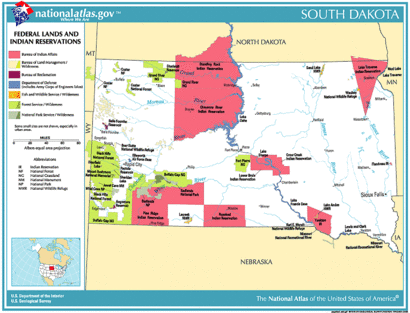
American Indians are a large part of the population. They are mostly Lakota, Dakota, and Nakota (Sioux). They are common in several counties. They make up 20% of the population in West River. The seven large Indian reservations in the state are much smaller than the original Great Sioux Reservation. South Dakota has the third-highest percentage of Native Americans in any state.
Five counties in the state are entirely within Indian reservations. Life on many South Dakota reservations can be difficult. This is due to the climate, land, and distance from cities. For example, Ziebach County was the poorest county in the U.S. in 2009. The unemployment rate in Fort Thompson is 70%. Many homes lack basic plumbing or kitchen appliances.
Languages Spoken
In 1995, a law made English the "common language" of the state. Since 2019, the language of the Great Sioux Nation is the official native language. This includes the Dakota, Lakota, and Nakota dialects. In 2010, most South Dakota residents (93.46%) spoke English at home. About 2.06% spoke Spanish. About 1.39% spoke Dakota. And 1.37% spoke German.
Population Changes
Over the past few decades, many rural areas in South Dakota have lost people. This is called "rural flight". It happens as family farming becomes less common. Young people often move to cities for jobs. This trend continues today. Between 1990 and 2000, 30 counties lost population. Nine counties lost more than 10% of their people. Harding County lost almost 19%.
Low birth rates and fewer young people moving in have made many counties older. In 24 counties, over 20% of the people are over 65. The national average is 12.8%.
However, not all areas have lost people. The Sioux Falls area, counties along Interstate 29, the Black Hills, and many Indian reservations have gained people. As reservations have more control, some Sioux have moved back. Lincoln County was one of the fastest-growing counties in the U.S. in 2010. These growing areas have made up for losses elsewhere. South Dakota's total population continues to grow.
Religion in South Dakota
Religious self-identification, per Public Religion Research Institute's 2022 American Values Survey Christianity (72%) Unaffiliated (21%) Buddhism (3%) New Age (3%)
In 2020, about 73% of adults in South Dakota were Christian. The largest Christian groups are Catholics, evangelical Protestants, and mainline Protestants. Together, all Protestants make up 57%. About 18% of the population does not belong to any religion. Other religions like Muslim, Hindu, and Buddhist make up less than 1% each. There are very few Jewish people in South Dakota.
The largest Christian groups in 2010 were the Roman Catholic Church, the Evangelical Lutheran Church in America (ELCA), and the United Methodist Church (UMC). In 2020, Catholicism was still the largest. Non-denominational Protestants became the third largest group.
In 2022, 72% of the state was Christian. Protestants were 48%, Catholics 22%, and Jehovah's Witnesses 2%. The number of people with no religion stayed around 21%. Other faith groups include Buddhism (3%) and New Age (3%). There are also small numbers of Baha'i Faith followers and Muslims.
South Dakota's Economy
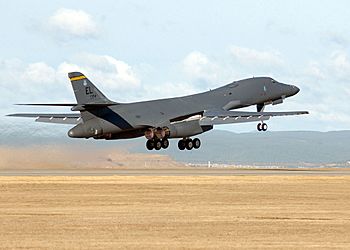
South Dakota's total economic output was $39.8 billion in 2010. This was the fifth smallest among U.S. states. The average income per person was $38,865 in 2010. About 12.5% of the people were below the poverty line in 2008. In 2010, South Dakota was ranked the seventh best state for business. In July 2011, the state's unemployment rate was 4.7%.
The service industry is the biggest part of South Dakota's economy. This includes retail, finance, and healthcare. Citibank moved its credit card business to Sioux Falls in 1981. This was because of good banking rules. Today, the trust fund industry manages huge amounts of money. It is known as a tax haven for people from other countries. Government spending is also important. It makes up over 10% of the state's economy. Ellsworth Air Force Base near Rapid City is the second largest employer in the state.
Farming has always been key to South Dakota's economy. Even though other industries have grown, farming is still very important. This is especially true in rural areas. The top five farm products are cattle, corn, soybeans, wheat, and hogs. Businesses related to farming, like meat packing and ethanol production, are also important. South Dakota is the sixth largest ethanol-producing state.
Tourism is another big part of the economy. Many people visit the state's attractions. These are mostly in the Black Hills region. Popular spots include historic Deadwood, Mount Rushmore, and national parks. One of the biggest tourist events is the annual Sturgis Motorcycle Rally. In 2015, over 739,000 people attended this five-day event. This is a huge number, considering the state's total population is about 850,000. In 2006, tourism created about 33,000 jobs. It also added over two billion dollars to South Dakota's economy.
Getting Around South Dakota
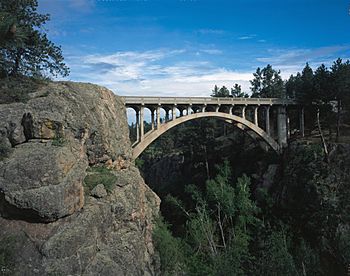
South Dakota has about 83,609 miles (134,555 km) of roads. This includes 679 miles (1,093 km) of interstate highways. Two main interstates cross South Dakota. Interstate 90 goes east and west through the southern part of the state. Interstate 29 goes north and south in the eastern part. Areas along I-29 usually have more people and economic growth.
There are also shorter interstates. I-190 goes into central Rapid City. I-229 circles southern and eastern Sioux Falls. Several major U.S. highways also pass through the state. South Dakota and Montana are the only states that share a land border without a paved road crossing it.
South Dakota has two National Scenic Byways. The Peter Norbeck National Scenic Byway is in the Black Hills. The Native American Scenic Byway runs along the Missouri River. Other scenic roads include the Badlands Loop, Spearfish Canyon, and Wildlife Loop Road.
Railroads have been important in South Dakota since the mid-1800s. About 4,420 miles (7,110 km) of track were built in the late 1800s and early 1900s. Today, only 1,839 miles (2,960 km) are active. BNSF is the largest railroad. The Rapid City, Pierre & Eastern Railroad is another major one. Most rail transport is for cargo. There are two passenger heritage railroads: the Black Hills Central and the Prairie Village, Herman, and Milwaukee. South Dakota is one of two states without Amtrak passenger train service.
South Dakota's biggest commercial airports are Sioux Falls Regional Airport and Rapid City Regional Airport. Several airlines serve these airports. Other cities also have commercial air service.
Public transit was once important in South Dakota cities. Seven cities had streetcar systems. But all of them stopped running over time. Today, only three cities have public bus systems. These are Sioux Falls, Rapid City, and the Yankton Reservation.
South Dakota's Culture
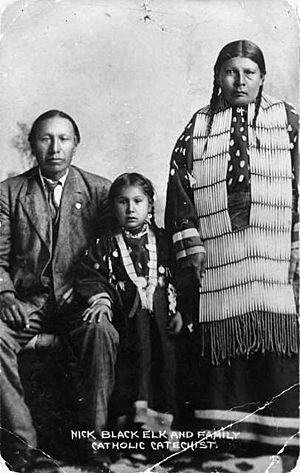
South Dakota's culture shows its American Indian, rural, Western, and European roots. Many events celebrate the state's history and different cultures. Examples include Days of '76 in Deadwood and Czech Days in Tabor. The various Native American tribes hold many annual pow wows. Sometimes, non-Native Americans are invited to these events. Custer State Park has an annual Buffalo Roundup. Volunteers on horseback gather the park's herd of about 1,500 bison.
Black Elk (Lakota) was a medicine man. His stories about the 1800s Indian Wars and Ghost Dance are in the book Black Elk Speaks. Paul Goble, a children's book author, lived in the Black Hills.
Laura Ingalls Wilder is one of South Dakota's most famous writers. Her books are based on her childhood on the frontier. Five of her novels are about her life near De Smet. These include By the Shores of Silver Lake and The Long Winter. Her books became very popular when Little House on the Prairie was made into a TV show.
South Dakota has also produced several famous artists. Harvey Dunn grew up on a farm in the late 1800s. He painted scenes of frontier life. Oscar Howe (Crow) was a famous watercolor painter. He was one of the first Native American painters to use modern art styles. Terry Redlin painted rural and wildlife scenes. Many of his works are at the Redlin Art Center in Watertown.
Cities and Towns in South Dakota
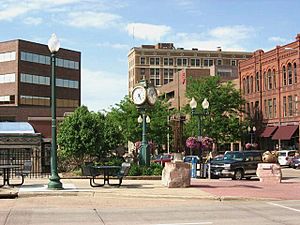
Sioux Falls is the biggest city in South Dakota. In 2020, it had 192,517 people. Its surrounding area had 281,958 people. The city was founded in 1856 in the southeast corner of the state. Its economy used to be about farming and quarrying. Now, retail, finance, and healthcare are more important.
Rapid City is the second largest city. In 2020, it had 74,703 people. Its surrounding area had 144,558 people. It is on the edge of the Black Hills and was founded in 1876. Rapid City's economy relies on tourism and defense spending. This is because of the many tourist spots and Ellsworth Air Force Base.
The next eight largest cities are:
- Aberdeen (28,495)
- Brookings (23,337)
- Watertown (22,655)
- Mitchell (15,660)
- Yankton (15,411)
- Huron (14,263)
- Pierre (14,091)
- Spearfish (12,193)
Pierre is the state capital. It is the second smallest state capital in the U.S. Brookings and Vermillion have the state's two largest universities. Only Rapid City and Spearfish are west of the Missouri River.
Media in South Dakota
South Dakota's first newspaper, the Dakota Democrat, started in Yankton in 1858. Today, the biggest newspaper is the Sioux Falls Argus Leader. The Rapid City Journal is the second largest. Other large newspapers include the Aberdeen American News and the Watertown Public Opinion. In 1981, Tim Giago started the Lakota Times for Native Americans. This newspaper is now called Indian Country Today and is available nationwide.
There are nine TV stations in South Dakota. South Dakota Public Television broadcasts from many places. Other stations broadcast from Sioux Falls or Rapid City. The two largest TV markets are Sioux Falls-Mitchell and Rapid City. The state's first TV station, KELO-TV, started in Sioux Falls in 1953. One of its early shows was Captain 11, a children's program. It ran for many years, making it the longest-running children's TV show in the nation.
Several South Dakotans are famous in TV and publishing. Tom Brokaw, a former news anchor, is from Webster and Yankton. Al Neuharth, who started USA Today, was from Eureka and Alpena. Game show host Bob Barker spent part of his childhood in Mission. Entertainment news hosts Pat O'Brien and Mary Hart are from Sioux Falls.
Education in South Dakota
In 2006, South Dakota had about 136,872 students in primary and secondary schools. Most (120,278) were in public schools. There are 703 public schools in 168 school districts. This means South Dakota has the most schools per person in the U.S. The high school graduation rate is 89.9%. The average ACT score is 21.8, which is slightly above the national average. About 89.8% of adults have a high school diploma. And 25.8% have a college degree or higher.
In 2008, South Dakota's average public school teacher salary was $36,674. This was the lowest in the nation. In 2007, South Dakota passed a law about Native American education. It requires teaching about Native American history and culture in all schools. This helps everyone learn about Indian culture. It also helps Indian students understand their own heritage.
The South Dakota Board of Regents controls the six public universities. South Dakota State University (SDSU) in Brookings is the largest. It has 12,831 students. The University of South Dakota (USD) in Vermillion is the oldest. It has the state's only law school and medical school. South Dakota also has private universities. The largest is Augustana University in Sioux Falls.
Sports and Fun in South Dakota
Organized Sports
South Dakota does not have any major professional sports teams. This is because it has a small population. But it does have minor league and independent teams. All of these teams play in Sioux Falls or Rapid City. Sioux Falls has four teams:
- Sioux Falls Canaries (baseball)
- Sioux Falls Skyforce (basketball)
- Sioux Falls Stampede (hockey)
- Sioux Falls Storm (indoor American football)
The Canaries play in the American Association. The Skyforce is owned by the NBA's Miami Heat. The Stampede and Storm share an arena. The Stampede plays in the USHL. The Storm plays in the IFL. Rapid City has a hockey team called the Rapid City Rush. They play in the ECHL.
Universities in South Dakota have many sports programs. For a long time, South Dakota was one of the only states without an NCAA Division I football or basketball team. But the South Dakota State Jackrabbits moved to Division I in 2007. The South Dakota Coyotes followed in 2011. Other universities compete at lower NCAA levels or in the NAIA.
Famous athletes from South Dakota include Billy Mills, Mike Miller, Mark Ellis, Becky Hammon, Brock Lesnar, Chad Greenway, and Adam Vinatieri. Billy Mills won a gold medal in the Olympics. Mike Miller is a two-time NBA champion. Becky Hammon played in the WNBA and coaches in the NBA. Brock Lesnar is a former UFC and WWE champion. Adam Vinatieri is a famous NFL kicker.
Recreational Activities
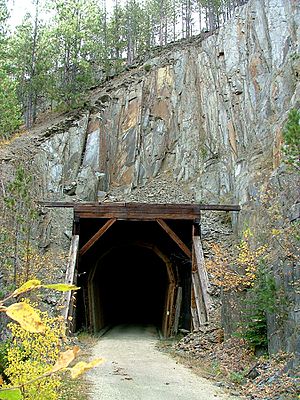
Fishing and hunting are popular outdoor activities. Fishing adds over $224 million to South Dakota's economy. Hunting adds over $303 million. In 2007, over 275,000 hunting licenses were sold. About half were bought by South Dakotans. Over 175,000 fishing licenses were sold. More than two-thirds were bought by South Dakotans.
Popular animals to hunt include pheasants, white-tailed deer, mule deer, and turkeys. Waterfowl like Canada geese and mallards are also hunted. People fish for walleye in the eastern lakes and Missouri River. They also fish for Chinook salmon in Lake Oahe and trout in the Black Hills.
Other sports like cycling and running are also popular. In 1991, the state opened the George S. Mickelson Trail. This is a 109-mile (175 km) trail in the Black Hills. Cyclists use it, and part of the Mount Rushmore marathon is run on it. Other events include the Tour de Kota, a long cycling event. The annual Sturgis Motorcycle Rally brings hundreds of thousands of people.
State Symbols
Here are some of South Dakota's official state symbols:
- State bird: Ring-necked pheasant
- State flower: American pasque flower
- State tree: Black Hills spruce
- State nicknames: Mount Rushmore State (official), Coyote state and Sunshine state (both unofficial)
- State motto: "Under God, the people rule"
- State slogan: "Great Faces. Great Places."
- State mineral: Rose quartz
- State insect: Honey bee (Apis mellifera)
- State animal: Coyote
- State fish: Walleye
- State gemstone: Fairburn agate
- State song: "Hail, South Dakota!"
See also
 In Spanish: Dakota del Sur para niños
In Spanish: Dakota del Sur para niños



